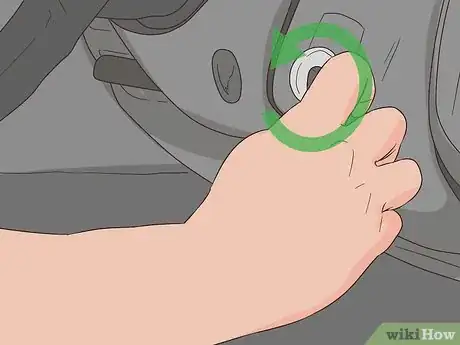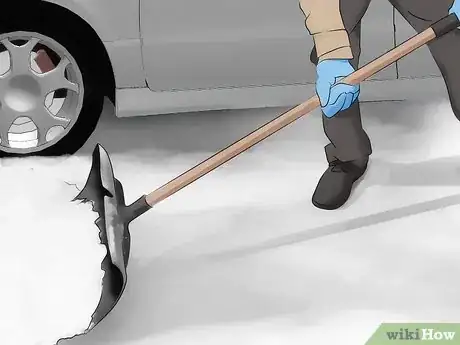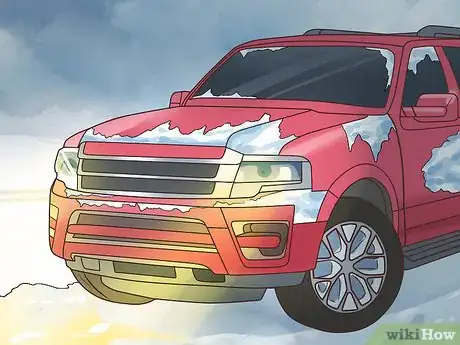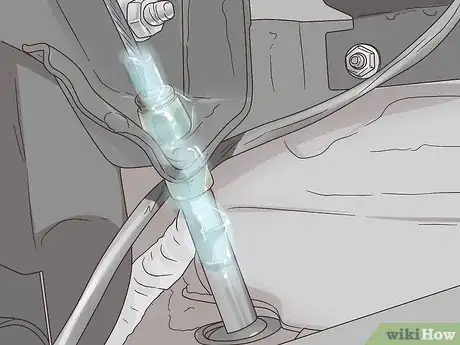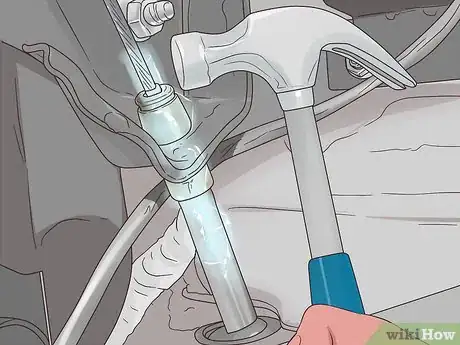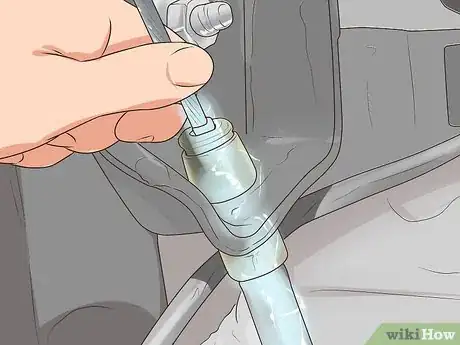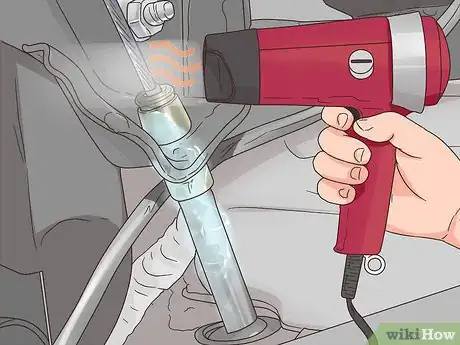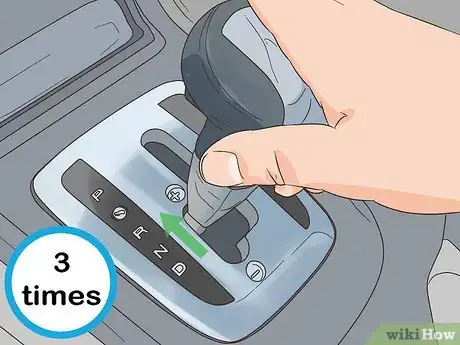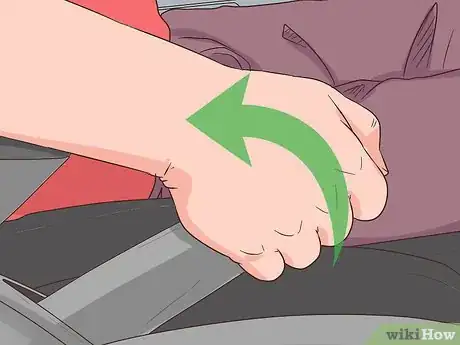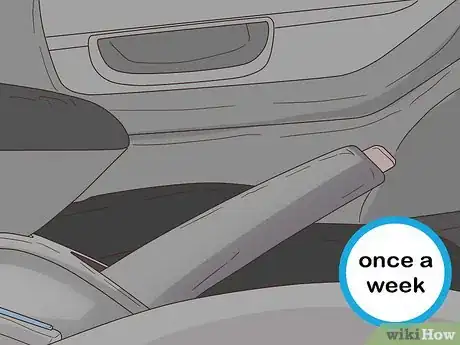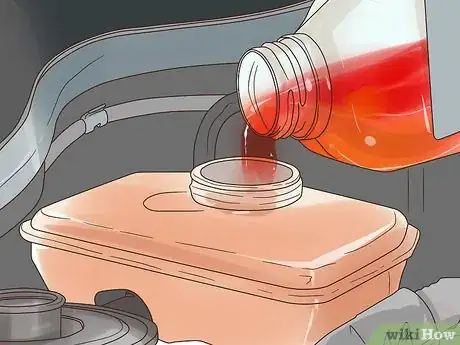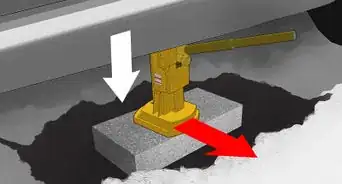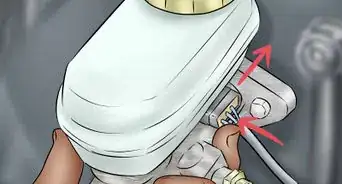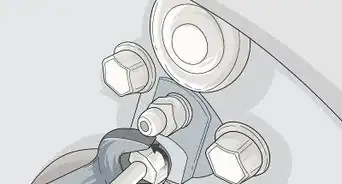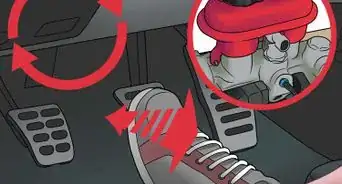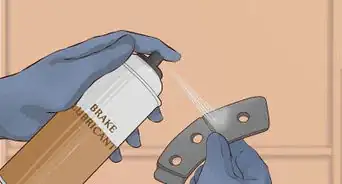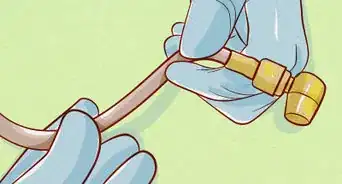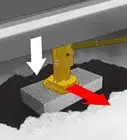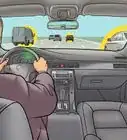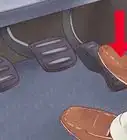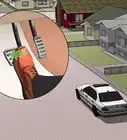This article was co-authored by Jason Shackelford and by wikiHow staff writer, Sophia Latorre. Jason Shackelford is the Owner of Stingray Auto Repair, a family owned and operated auto repair shop with locations in Seattle and Redmond, Washington. He has over 24 years of experience in auto repair and services, and every single technician on Jason’s team has more than 10 years of experience.
There are 7 references cited in this article, which can be found at the bottom of the page.
This article has been viewed 426,719 times.
A parking brake, also called an emergency brake, e-brake, or hand brake, is used to take strain off of the transmission when the vehicle is parked.[1] If your parking brake is frozen or stuck, there are several techniques you can try to release it. The methods to try will depend on whether you're dealing with the results of cold weather, or with rust.
Steps
Warming Up a Car in Cold Weather
-
1Start the car first. Release and set the brake repeatedly in an attempt to help dislodge any ice from the brake system.
-
2Block as much of the open space between the ground and sides of the vehicle if the brake is still frozen. Shovel snow or arrange other material along the sides of the vehicle. Doing this will create a path for air flow from front to rear of the vehicle, minimizing “losses” from under the vehicle’s sides.
- The objective is to get the heat created by the engine and circulated to the radiator at the front of the vehicle, to the rear of the vehicle where most of the parking brake components are located (adjust for locations that differ from those offered in this article). Creating a “channel” under the vehicle by piling snow, etc. in the space under the sides of the vehicle accomplishes just that.
Advertisement -
3Allow the car to warm up. If ice is preventing the release of your parking brake, warming up the car can help melt the ice and free the brake. Start the car and leave it running for at least 10 minutes before attempting to release the parking brake.[2]
- Wait outside the vehicle while it is running. Once the engine has warmed, the heated air pulled through the radiator by the fan and heat created by the exhaust system will pass under the length of the vehicle. The more effort used to “seal” the open spaces under the sides of the vehicle, ensures that the warm air passes under its entire length and allows the thaw process to complete in the least amount of time.
-
4Attempt to release the brake again. If still frozen, allow more time for the heat created by the vehicle to continue thawing and/or block open spaces at the front and rear of the vehicle, too (this is particularly helpful if it is gusty or windy). Pushing down the accelerator slightly will increase heat, and speed up the engine’s mechanical fan, which will force more warm air under the vehicle.
- However, many newer cars, especially those that are front wheel drive, will not have a mechanical fan. The electric fans in these vehicles are not affected by engine speed and will only turn on once the coolant has reached a pre-determined temperature.
Removing and Melting Ice
-
1Inspect the parking brake and cable for ice. The parking brake is connected to the brake shoe on one of your tires by a thin black cable. If you aren’t sure which one it’s connected to, check the owner’s manual for the vehicle or look online. Then, inspect the parking brake and the parking cable for ice or damage.[3]
- A brake shoe is a long, curved piece of metal pressed against the brake drums.
- If you see damage, corrosion, rust, or other problems with the parking brake or cable, contact a certified mechanic.
-
2Chip off ice from the parking brake with a hammer. You can use a hammer or a mallet to remove ice stuck to the parking brake. Direct your strikes at the ice only, and don’t hit it so hard that you damage or dent the brake components.[4]
-
3Move the cable around to free ice surrounding it. Gently wiggle the cable back and forth. It should move freely. If it doesn’t, inspect the area for ice built up around the cable. Use your fingers to chip or pry away any ice that could be keeping the parking brake from releasing.[5]
-
4Blow-dry the parking brake and cable if ice remains. Plug in a blow dryer and turn it to high, using the hottest setting available. Direct the hot air at the parking brake and cable to melt any ice that could prevent the brake from releasing.[6]
- You may need to use an extension cord in order to use the blow dryer outdoors.
-
5Attempt to free the brake 10 times before contacting a mechanic. Use the lever inside your car that releases the parking brake. Trying to release the brake multiple times can help dislodge the ice frozen around it. If the brake doesn’t release after 10 tries, you should contact a certified mechanic.[7]
- Your car will need to be towed to a shop if the parking brake is still frozen or stuck.
Dealing with Rust
-
1Pump the brakes 10 times. If your parking brake is stuck due to rust, you may be able to dislodge some the of rust and free the brake. Sit inside the vehicle and pump the brakes 10 times. Be sure to push the brake pedal down as far as it will go and let it release all the way before applying pressure again.[8]
-
2Shift the car from drive to reverse 3 times. Engaging the transmission can sometimes help free a stuck parking brake. Keep 1 foot on the brake pedal and shift from drive to reverse. Then, shift from reverse back to drive and repeat the sequence 3 times.[9]
- When you’re done, put the vehicle in park (for an automatic transmission) or neutral (for a manual transmission).
-
3Try to release the parking brake. Use the lever to disengage the parking brake. If it doesn’t work on the first try, you can keep trying up to 10 times. If the parking brake is still stuck, the cable may need to be replaced. Speak to a certified mechanic for an official diagnosis.[10]
Preventing Parking Brake Problems
-
1Use the parking brake at least once a week to prevent rust. If you don’t use your parking brake often, it’s easy for the metal to rust. Aim to use the parking brake each time you park the vehicle, or at least once a week.
-
2Lube the cable each time you get an oil change. Lubricating the parking brake occasionally can prevent it from sticking. If you do your oil changes yourself, apply a pea-sized amount of lubricant to the parking brake cable each time you change the oil. If you have your oil changes done in a shop, ask the mechanic to lube the parking brake cable for you.[11]
-
3Ensure the brake fluid is topped off. If your car is low on brake fluid, it could lead to problems with the parking brake. Aim to check all of your fluids each time you get gasoline. If you ever notice that the brake fluid is low, fill it up to the recommended level.[12]
Expert Q&A
-
QuestionHow do you manually release an emergency brake?
 Jason ShackelfordJason Shackelford is the Owner of Stingray Auto Repair, a family owned and operated auto repair shop with locations in Seattle and Redmond, Washington. He has over 24 years of experience in auto repair and services, and every single technician on Jason’s team has more than 10 years of experience.
Jason ShackelfordJason Shackelford is the Owner of Stingray Auto Repair, a family owned and operated auto repair shop with locations in Seattle and Redmond, Washington. He has over 24 years of experience in auto repair and services, and every single technician on Jason’s team has more than 10 years of experience.
Auto Technician If your emergency brake is a foot pedal, there's most likely a release lever on top of the pedal that you can pull.
If your emergency brake is a foot pedal, there's most likely a release lever on top of the pedal that you can pull.
Warnings
- Never drive a vehicle with the parking brake engaged, as this could cause serious damage.⧼thumbs_response⧽
References
- ↑ https://www.autoblog.com/2016/07/11/how-to-release-a-stuck-parking-brake/
- ↑ https://youtu.be/B__NrqqWcLc?t=6
- ↑ https://www.yourmechanic.com/article/how-to-release-a-stuck-parking-brake-by-bren
- ↑ https://www.yourmechanic.com/article/how-to-release-a-stuck-parking-brake-by-bren
- ↑ https://www.yourmechanic.com/article/how-to-release-a-stuck-parking-brake-by-bren
- ↑ https://www.yourmechanic.com/article/how-to-release-a-stuck-parking-brake-by-bren
- ↑ https://youtu.be/B__NrqqWcLc?t=17
- ↑ https://www.reference.com/vehicles/release-stuck-parking-brake-3c931fa83526138d
- ↑ https://www.reference.com/vehicles/release-stuck-parking-brake-3c931fa83526138d
